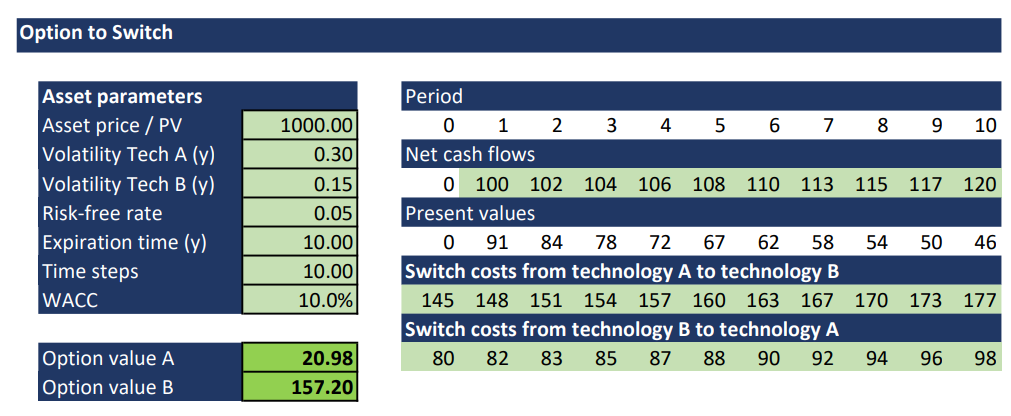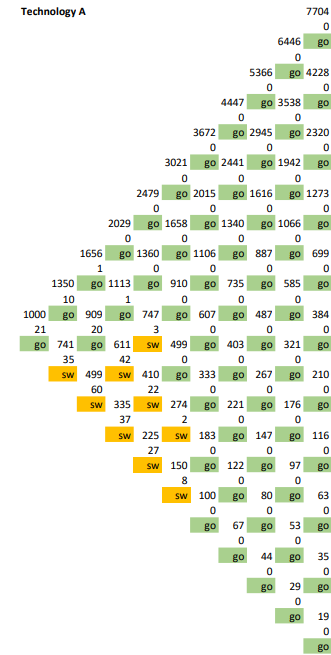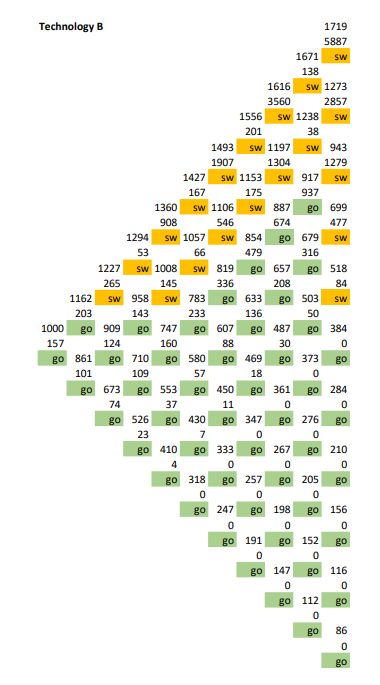Problem Framing
In this post I want to give a simple example of a swich option valuation. The considered project lasts 10 years, the WACC of the contribution (market) cash flows is 10.0% and constant over time. The contribution cash flows are shown in the graph below. Let the risk free rate be 5.0%. The project provides 2 operation modes (possibilities), one with technology A and the other with technology B. A Monte-Carlo-Simulation of technology A shows a project’s contribution cash flow volatility of 0.30. The corresponding Monte-Carlo-Simuation of technology B provides a project’s contribution cash flow volatility of 0.15. We analyze this switch option with a binomial approach. As time periods we choose one time step per year, so that you can read the figures in the lattices. For higher accuracy we could take smaller time periods anytime. The present value of the project market contribution cash flows is 1 million USD. Switch costs from technology A to B start with 145 kUSD, from technology B to A start with 80 KUSD. These costs increase with an inflation rate of 2.0%.
Switch Option Valuation
We want to give answers to the following questions: What is the value of this option to switch between technology A and technology B? How much can we invest in this flexibility keeping a positive added value to the project? And when do I have to switch between the 2 technologies to get the maximum value added?
We take the binomial approach from Cox-Ross-Rubinstein to solve that issue. Following you can have look at the binomial lattices for both technologies. The first value of each node is the value of the underlying (market contribution cash flows), the sevond value is the value of the switch option at the corresponding node. In the third line you can see whether you have to switch to the other technology or not (“sw” means to switch, “go” means to stay in the technology).


The value of the switch option starting with technology A is 21 kUSD. Starting with technology B the switch option value is 157 kUSD. If the investment for the switch option flexibility is below these option values, you should do the investment. If you can choose the starting technology, you should start with B. This results in a higher value added, the corresponding investments not taken into account. In the first year you have to make no switch in any case. In the second year it depends on the cash flow development, if you start with technology A. Switch in the bad case to technology B and stay in technology A in case of positive development. Starting with technology B you should stay there and make no switch, independent of the cash flow development. In the third year you should switch to technology A in the best cash flow development. Analyzing the event/option tree through time in this way provides a guideline for what to do in which year, depending on the cash flow development.
Note that this switch option adds a value of 157 kEUR to the project. That means that the NPV of the classical DCF analysis can convert from negative to positive because of this additional value. That could lead to a reconsidering of the project decision. The ENPV (expanded NPV) is the NPV of the project plus the value of the switch option.
Additional Remarks
I constructed the event tree from the project’s contribution cash flow volatilities out of Monte-Carlo-Simulations. Of course you can also create the nodes of the event trees by calculating the time values of the outstanding contribution cash flows explicitly. Discussion with management and marketing can provide the required cash flows and probabilities of the event tree.
This switch option valuation approach can be applied to many problems with different operation possibilities. Switch options are compound options with path-dependency. They are a good examples that real options can be more complicated than financial options. Analytical valuation methods like Black-Scholes-Merton cannot give you a solutions for problems like that.
